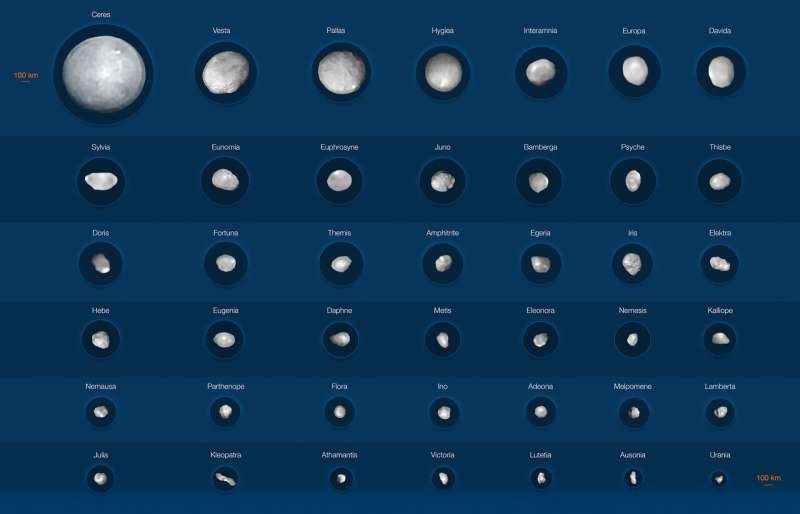The detailed images of these 42 objects are a leap forward in exploring asteroids, made possible thanks to ground-based telescopes, and contribute to answering the ultimate question of life, the Universe, and everything.
"Only three large main belt asteroids, Ceres, Vesta and Lutetia, have been imaged with a high level of detail so far, as they were visited by the space missions Dawn and Rosetta of NASA and the European Space Agency, respectively," explains Pierre Vernazza, from the Laboratoire d'Astrophysique de Marseille in France, who led the asteroid study published today in Astronomy & Astrophysics. "Our ESO observations have provided sharp images for many more targets, 42 in total."
The previously small number of detailed observations of asteroids meant that, until now, key characteristics such as their 3-D shape or density had remained largely unknown. Between 2017 and 2019, Vernazza and his team set out to fill this gap by conducting a thorough survey of the major bodies in the asteroid belt.
Most of the 42 objects in their sample are larger than 100 km in size; in particular, the team imaged nearly all of the belt asteroids larger than 200 kilometers, 20 out of 23. The two biggest objects the team probed were Ceres and Vesta, which are around 940 and 520 kilometers in diameter, whereas the two smallest asteroids are Urania and Ausonia, each only about 90 kilometers.
By reconstructing the objects' shapes, the team realized that the observed asteroids are mainly divided into two families. Some are almost perfectly spherical, such as Hygiea and Ceres, while others have a more peculiar, "elongated" shape, their undisputed queen being the "dog-bone" asteroid Kleopatra.
By combining the asteroids' shapes with information on their masses, the team found that the densities change significantly across the sample. The four least dense asteroids studied, including Lamberta and Sylvia, have densities of about 1.3 grams per cubic centimeter, approximately the density of coal. The highest, Psyche and Kalliope, have densities of 3.9 and 4.4 grams per cubic centimeter, respectively, which is higher than the density of diamond (3.5 grams per cubic centimeter).
This large difference in density suggests the asteroids' composition varies significantly, giving astronomers important clues about their origin. "Our observations provide strong support for substantial migration of these bodies since their formation. In short, such tremendous variety in their composition can only be understood if the bodies originated across distinct regions in the Solar System," explains Josef Hanuš of the Charles University, Prague, Czech Republic, one of the authors of the study. In particular, the results support the theory that the least dense asteroids formed in the remote regions beyond the orbit of Neptune and migrated to their current location.
These findings were made possible thanks to the sensitivity of the Spectro-Polarimetric High-contrast Exoplanet REsearch (SPHERE) instrument mounted on ESO's VLT. "With the improved capabilities of SPHERE, along with the fact that little was known regarding the shape of the largest main belt asteroids, we were able to make substantial progress in this field," says co-author Laurent Jorda, also of the Laboratoire d'Astrophysique de Marseille.
Astronomers will be able to image even more asteroids in fine detail with ESO's upcoming Extremely Large Telescope (ELT), currently under construction in Chile and set to start operations later this decade. "ELT observations of main-belt asteroids will allow us to study objects with diameters down to 35 to 80 kilometers, depending on their location in the belt, and craters down to approximately 10 to 25 kilometers in size," says Vernazza. "Having a SPHERE-like instrument at the ELT would even allow us to image a similar sample of objects in the distant Kuiper Belt. This means we'll be able to characterize the geological history of a much larger sample of small bodies from the ground."
Explore further

